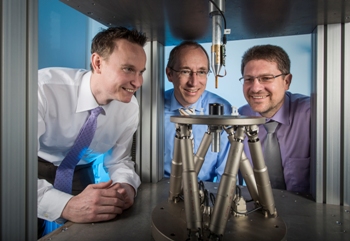Magnetic field sensors are a contact- and wear-free means of measuring the position of machine parts and products. A new generation of Hall sensors is now making the process even more precise and free of interference.
 A 3D Hall sensor developed by Dr.-Ing. Markus Stahl-Offergeld, Dr.-Ing. Hans-Peter Hohe and Michael Hackner (from left to right) can measure position exactly. © Dirk Mahler/Fraunhofer
A 3D Hall sensor developed by Dr.-Ing. Markus Stahl-Offergeld, Dr.-Ing. Hans-Peter Hohe and Michael Hackner (from left to right) can measure position exactly. © Dirk Mahler/Fraunhofer
Magnetic field sensors are used to measure the position of machine parts and products with zero contact and zero wear – in a modern car, around 100 of such sensors are busy monitoring safety belt buckles and door locks, registering pedal positions, or are used for ABS, EPS, and engine control. They are cost-effective and robust, however, these conventional sensors generally measure only the magnitude of the magnetic field perpendicular to the chip surface. Good enough in many ways, magnetic field measurement remains imprecise and susceptible to interference. Michael Hackner, Dr.-Ing. Hans-Peter Hohe, and Dr.-Ing. Markus Stahl-Offergeld from the Fraunhofer Institute for Integrated Circuits IIS were not satisfied with these limitations. They wanted precise position measurement with the advantages of magnetic field sensors, and so they set about developing a 3D Hall sensor.
Manufactured using standard processes
“First we connected up several sensors on a chip in order to improve the measuring accuracy of the individual sensors,” says Markus Stahl-Offergeld. “Next we arranged several of these sensors to measure the three-dimensional magnetic field at one point. The result was our pixel cells.” And so a new generation of 3D Hall sensors was born, capable of measuring all three spatial axes of a magnetic field and calculating the exact position of an object. The sensor chip contains a designated sensor for each of the three magnetic axes. These sensors are placed together in the pixel cell and attain a resolution of just a few microteslas depending on the measurement speed. Tesla is the unit for magnetic flux density. Also integrated directly on the chip are the evaluation circuit and a coil, which enable self-testing and calibration. “In spite of its complexity, the HallinOne® magnetic sensor can be manufactured using standard processes of semiconductor technology – and that makes it cost-effective,” explains Dr.-Ing. Hans-Peter Hohe. For this global technological breakthrough, the three Fraunhofer IIS developers have been awarded a Joseph von Fraunhofer prize this year.
Long-term partnership
One of the first companies to exploit the potential of HallinOne® was Seuffer GmbH from Calw in southern Germany. As far back as 2006, it launched a sensor that prevents washing machines from wobbling and creeping across the floor during spin cycles. A magnet is attached to the tub and the sensor to a fixed, unmoving part of the washing machine. Depending on how much washing is in the drum and how it is distributed during a spin cycle, the tub moves and therefore the magnet, too. The sensor measures this movement, evaluates the data, and transmits it to the washing machine. If the drum is wobbling, it is stopped briefly and shaken around a bit in order to distribute the washing more evenly. Fraunhofer IIS and Seuffer are currently developing a wireless window sentinel, which detects whether a window is open or closed and transmits this information via a wireless sensor network combined with energy harvesting.
“Our next goal is to develop a sensor for 5-axis position measurement,” says Michael Hackner. “This will allow us to detect more mechanical degrees of freedom simultaneously, including translatory and rotary movements by the magnet in all directions. It already works in laboratory tests, but the system still needs some adjustments before it is ready for real-life applications.” Such applications could include use in the control systems of computers, construction machines, robots and airplanes.